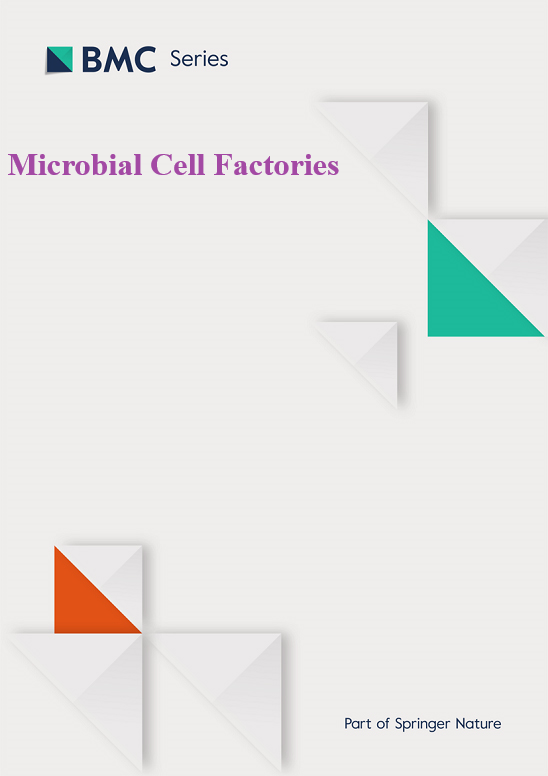全合成信号肽库的设计及其在谷氨酸棒杆菌中用于增强重组蛋白质的分泌生产
IF 4.3
2区 生物学
Q1 BIOTECHNOLOGY & APPLIED MICROBIOLOGY
引用次数: 0
摘要
谷氨酸棒杆菌(Corynebacterium glutamicum)是一种极具吸引力的宿主,可用于分泌性生产重组蛋白,包括高价值的工业酶和治疗蛋白。选择合适的信号肽对高效分泌蛋白质至关重要。然而,由于谷氨酸棒状杆菌中的信号肽有限,建立一个最佳的分泌系统具有挑战性。我们构建了一个信号肽库,用于分离目标特异性信号肽,并在谷氨酸蘑菇中开发了一个高效分泌生产系统。根据谷氨酸菌一般分泌依赖途径信号肽的序列信息,我们设计了一个合成信号肽库,并用三个蛋白质模型进行了验证。首先,我们研究了木聚糖酶(XynA),通过在含木聚糖的琼脂平板上进行文库筛选,成功分离出了一个潜在的信号肽(C1)。利用 C1 信号肽,XynA 的分泌产量可高达 3.2 克/升,且纯度很高(> 80%)。接着,在含淀粉的琼脂平板上筛选了淀粉酶(AmyA)的信号肽。分离出的信号肽(HS06)的生产滴度达到 1.48 g/L,比著名的 Cg1514 信号肽高出 2 倍。最后,我们分离出了 M18 单链可变片段(scFv)的信号肽。作为一种与酶无关的筛选工具,我们利用荧光激活和吸收位移标签(FAST)融合技术开发了一种荧光依赖性筛选工具,并成功分离出了 M18 scFv 的最佳信号肽(18F11)。使用 18F11 后,分泌物产量高达 228 毫克/升,是之前结果的 3.4 倍。通过筛选全合成信号肽文库,与之前使用知名信号肽的结果相比,我们提高了目标蛋白的产量。我们的合成库为谷氨酸棒杆菌开发各种重组蛋白的最佳分泌系统提供了有用的资源,我们相信这种细菌将成为生物产业中更有前途的主力军。本文章由计算机程序翻译,如有差异,请以英文原文为准。
Design of fully synthetic signal peptide library and its use for enhanced secretory production of recombinant proteins in Corynebacterium glutamicum
Corynebacterium glutamicum is an attractive host for secretory production of recombinant proteins, including high-value industrial enzymes and therapeutic proteins. The choice of an appropriate signaling peptide is crucial for efficient protein secretion. However, due to the limited availability of signal peptides in C. glutamicum, establishing an optimal secretion system is challenging. We constructed a signal peptide library for the isolation of target-specific signal peptides and developed a highly efficient secretory production system in C. glutamicum. Based on the sequence information of the signal peptides of the general secretion-dependent pathway in C. glutamicum, a synthetic signal peptide library was designed, and validated with three protein models. First, we examined endoxylanase (XynA) and one potential signal peptide (C1) was successfully isolated by library screening on xylan-containing agar plates. With this C1 signal peptide, secretory production of XynA as high as 3.2 g/L could be achieved with high purity (> 80%). Next, the signal peptide for ⍺-amylase (AmyA) was screened on a starch-containing agar plate. The production titer of the isolated signal peptide (HS06) reached 1.48 g/L which was 2-fold higher than that of the well-known Cg1514 signal peptide. Finally, we isolated the signal peptide for the M18 single-chain variable fragment (scFv). As an enzyme-independent screening tool, we developed a fluorescence-dependent screening tool using Fluorescence-Activating and Absorption-Shifting Tag (FAST) fusion, and successfully isolated the optimal signal peptide (18F11) for M18 scFv. With 18F11, secretory production as high as 228 mg/L was achieved, which was 3.4-fold higher than previous results. By screening a fully synthetic signal peptide library, we achieved improved production of target proteins compared to previous results using well-known signal peptides. Our synthetic library provides a useful resource for the development of an optimal secretion system for various recombinant proteins in C. glutamicum, and we believe this bacterium to be a more promising workhorse for the bioindustry.
求助全文
通过发布文献求助,成功后即可免费获取论文全文。
去求助
来源期刊

Microbial Cell Factories
工程技术-生物工程与应用微生物
CiteScore
9.30
自引率
4.70%
发文量
235
审稿时长
2.3 months
期刊介绍:
Microbial Cell Factories is an open access peer-reviewed journal that covers any topic related to the development, use and investigation of microbial cells as producers of recombinant proteins and natural products, or as catalyzers of biological transformations of industrial interest. Microbial Cell Factories is the world leading, primary research journal fully focusing on Applied Microbiology.
The journal is divided into the following editorial sections:
-Metabolic engineering
-Synthetic biology
-Whole-cell biocatalysis
-Microbial regulations
-Recombinant protein production/bioprocessing
-Production of natural compounds
-Systems biology of cell factories
-Microbial production processes
-Cell-free systems
 求助内容:
求助内容: 应助结果提醒方式:
应助结果提醒方式:


